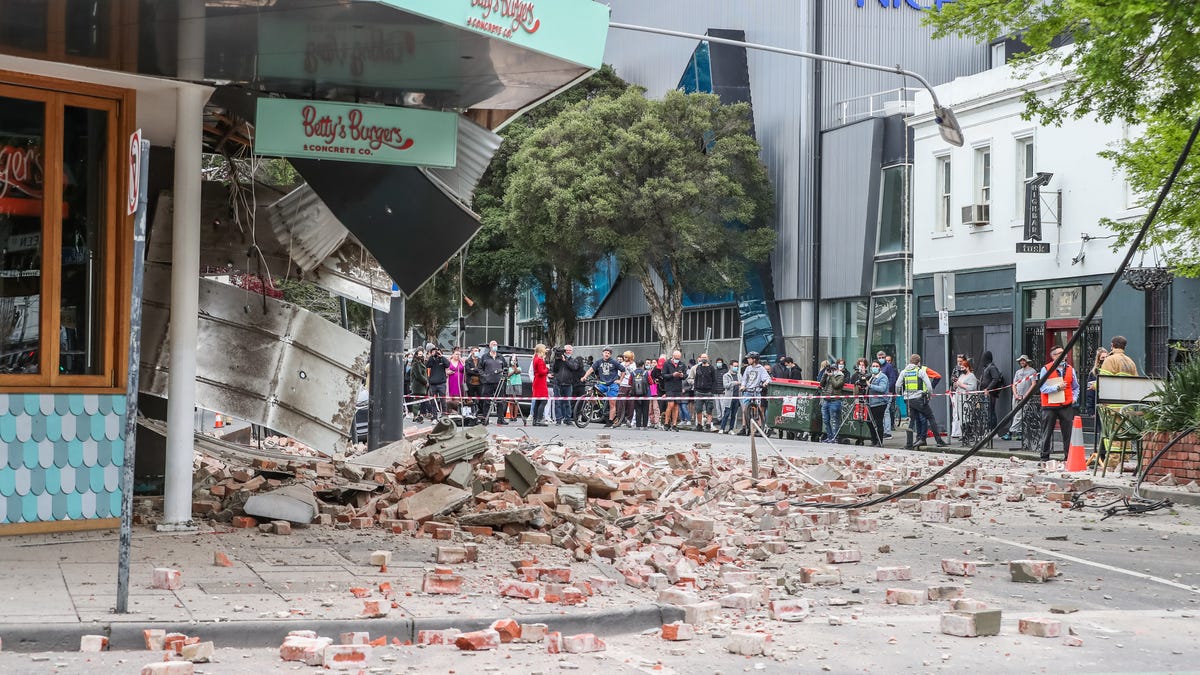Australia hit by its biggest earthquake in years
As the country grapples with continuing COVID-19-related protests, it got a bad omen in the form of an unlikely earthquake.

A building crumbled in Melbourne after a 5.8-magnitude earthquake 130 miles north east of the city.
While Australia is known for its poisonous wildlife and blazing bushfires, earthquakes aren't typically associated with the faraway country. That's why millions of Australians were shocked on Wednesday morning local time when a 5.8-magnitute earthquake hit in Victoria.
The tremor originated in a town 130 miles northeast of Melbourne, the country's second most populous city. Buildings in the center of Melbourne shook, and at least one crumbled, though none collapsed and there are no known fatalities. The tremor was accompanied by two smaller earthquakes, according to Geoscience Australia, and was also felt in Sydney and Canberra.
The quake was caught on the national broadcaster's Melbourne breakfast news show, with hosts Michael Rowland and Tony Armstrong stunned at the vibrations rocking the entire building. Social media was flooded by Australians in Melbourne documenting the damage, as well as posts from Sydney and Canberra confirming they felt the tremor too.
A magnitude six #Earthquake has rattled Melbourne and regional Victoria.
— News Breakfast (@BreakfastNews) September 21, 2021
This is the moment when News Breakfast presenters @mjrowland68 and @Tonaaayy_ were rocked by it. pic.twitter.com/Z4gz0sWJve
Chapel St.
— Tom Robertson (@TomCRobertson) September 21, 2021
Wow. https://t.co/UeYIdJAr7j pic.twitter.com/1nksq7YkO7
Bricks and debris on side street next to Coles on Chapel Street, opposite Prahran Square shopping mall.
— Euan Black (@euanblackwrites) September 22, 2021
The #earthquake really shook our apartment building nearby. Windows rattled. Walls shook. Floor felt like it was moving. Many tenants out on the street within minutes. pic.twitter.com/2w0AbqTCCb
The earthquake is notable not for its destruction but for how unusual such quakes are in Australia. High-magnitude earthquakes are rare, and when they do occur are usually located in the country's vast outback, faraway from the coastal areas where over 80% of the population lives. A 6.6-magnitude earthquake in 1988 is the most severe tectonic shocks recorded within the country, but caused relatively little damage due to being located in the population-sparse Northern Territory. A 1989 earthquake is New South Wales in the country's most deadly, killing 13.
Yet, Wednesday's earthquake comes at a volatile time for Melbourne, a city that's been beleaguered by anti-lockdown protests in recent days. Melbourne is in the midst of a second wave of COVID-19, with case numbers nearing the peak reached last August, leading many to tweet about how bad an omen the unexpected earthquake is.
Victoria, 2021: pic.twitter.com/IMmElCZjhd
— Benita Kolovos (@benitakolovos) September 22, 2021
This year is getting to the point where we need to sacrifice a goat and wear torn clothes in atonement or some shit like that #earthquake
— Nyadol Nyuon (@NyadolNyuon) September 21, 2021
No more horses of the apocalypse, please. Hope everyone OK. #earthquake
— Chief Health Officer, Victoria (@VictorianCHO) September 22, 2021
When the police said they were deploying 'different tactics' in response to the Melbourne protests, firing up the earthquake machine was not something I had on the pick list. #earthquake #Melbourneearthquake
— Peter Clarke (@Renegadecrafts) September 21, 2021
Geoscience Australia warned that more aftershocks could be coming, with the organization's senior seismologist, Trevor Allen, telling the ABC: "It looks as if this was potentially the largest earthquake we have experienced in Victoria since European settlement."

